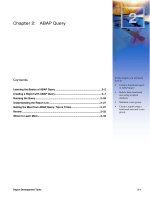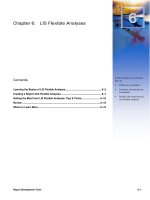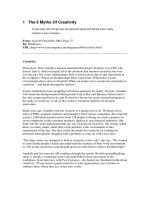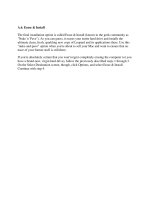Tài liệu Chapter 6: LIS Flexible Analyses pdf
Bạn đang xem bản rút gọn của tài liệu. Xem và tải ngay bản đầy đủ của tài liệu tại đây (338.96 KB, 20 trang )
Report Development Tools 6–1
Chapter 6: LIS Flexible Analyses
Contents
Learning the Basics of LIS Flexible Analyses.....................................................6–2
Creating a Report with Flexible Analyses............................................................6–7
Getting the Most from LIS Flexible Analyses: Tips & Tricks ...........................6–18
Review ...................................................................................................................6–19
Where to Learn More............................................................................................6–19
6
In this chapter you will learn
how to:
Define an evaluation
Generate and execute an
evaluation
Modify the report layout
of a flexible analysis
Chapter 6: LIS Flexible Analyses
Learning the Basics of LIS Flexible Analyses
Reporting Made Easy
6–2
Learning the Basics of LIS Flexible Analyses
In this chapter you will learn about flexible analyses in the Logistics Information System
(LIS). Flexible analysis is a presentation tool that is used primarily to display the contents of
LIS information structures.
What Is Flexible Analysis?
Flexible analysis gives you an adaptable way of combining and aggregating key figures to
suit user requirements. This flexibility helps meet the information needs of users at different
levels in an enterprise. For example, flexible analyses can provide administrators with
detailed information and management with aggregated information. You can also define
additional key figures by applying mathematical formulas to existing key figures.
Flexible analyses can be:
< Displayed on screen in a table format
< Exported (or downloaded) to other applications in the following formats:
Microsoft Excel spreadsheet
Word document
Dbase
HTML
Flat file
< Saved as an extract which can be viewed later
Flexible analysis is used to execute an evaluation (or report). An evaluation is based on an
evaluation structure. You can use flexible analyses to extract data from an information
structure, via an evaluation structure. All information structures are automatically available
as evaluation structures, regardless of whether they were delivered with the R/3 System or
created by the configuration team. Therefore, to execute an evaluation, you do not need to
create a new evaluation structure. Simply use an existing evaluation structure, for example
S001E.
How Is Flexible Analysis Different From Standard Analysis?
Unlike LIS Standard analyses, with flexible analyses you can:
< View data in a single report, complete with grand totals, subtotals, sub-sub totals, etc.
without having to drill down into the report.
< Create formulas and calculations with greater ease.
< Combine data from multiple information structures and Logistics applications in a
single report.
Chapter 6: LIS Flexible Analyses
Learning the Basics of LIS Flexible Analyses
Report Development Tools
6–3
How Is LIS Flexible Analysis Organized?
As shown in the graphic below, flexible analysis consists of the following four layers:
< Physical data basis: The bottom layer contains information structures and DDIC (data
dictionary) tables which store data. One of the first things to do after you decide to use a
flexible analysis is to decide what tables to use to generate the report.
< Logical data view: Evaluation structures provide a logical view of the information
structures or database tables. They do not contain any data, but list the characteristics
and key figures that are available for reporting.
< Data collection: The evaluation is the definition of your report. This is where you define
which characteristics and key figures you want to see in your report. This is also where
you define the report layout and the formulas to include in your report.
< Data presentation: The result (or output) of executing your evaluation is delivered to
the user in the form of a list.
DDIC
Tables
Info
Structures
Evaluation
Structure
Evaluation
List
Physical Data Basis
Logical Data View
Data Collection
Data Presentation
In general, a flexible analysis refers to the following activities:
< Defining, changing, and displaying an evaluation
< Executing an evaluation (running the report)
< Varying the report layout
< Creating, changing, and displaying an evaluation structure with reference to either an
evaluation structure or a data dictionary table
Chapter 6: LIS Flexible Analyses
Learning the Basics of LIS Flexible Analyses
Reporting Made Easy
6–4
Terminology
It is helpful to be familiar with some of the essential terms and concepts used with LIS
Flexible analyses.
Information structure
An information structure stores aggregated data resulting from transactions. The three types
of data stored in an information structure are:
< Characteristics
< Key figures
< Periodicity (period unit)
An information structure is a transparent table. For each information structure
generated, a separate database table is created. Among them are Sxxx and SxxxE , where
xxx represents the number of the information structure. For a list of SAP-delivered
information structures, refer to appendix E. Some of the tables related to LIS can be
found in the data dictionary under tables that begin with TMC.
Information structures are special tables but they are different from the document tables.
While the document tables store all the detailed information about your documents (such as
sales orders and invoices), the information structures store data aggregated by
characteristics and period unit.
Example: S001 (in the Sales Information System) is an information structure. It
contains data related to customers (for example, sales orders, deliveries, and invoices).
Characteristic
A characteristic is a dimension of your business for which you collect data (also the
aggregation or subtotal levels).
Examples of characteristics include sales organization, purchasing organization, plant, sold-
to party, vendor, storage location, material group, and material.
Key figure
A key figure is a measure of the business data you are collecting.
Examples of key figures include, incoming order value (booking value), incoming order
quantity (booking quantity), invoiced sales value, invoiced sales quantity, PO order
quantity, PO order value, goods receipt quantity, valuated stock quantity, and valuated
stock value.
Chapter 6: LIS Flexible Analyses
Learning the Basics of LIS Flexible Analyses
Report Development Tools
6–5
Periodicity (or Period unit)
The period unit used for aggregating the data stored in the information structure. The
period unit can be daily, weekly, monthly, or by fiscal period (using the fiscal year variant
established by the finance team). Do not confuse this with periodic loads of data.
Note: Some information structures do not appear to have periodicity. In such cases,
these information structures are actually built from the data contained in other
information structures. As the source information structure itself contains a periodicity,
the target information structure “inherits” the periodicity of the source information
structure.
Evaluation structure
An evaluation structure presents a logical view of the data in the information structure.
Unlike information structures, evaluation structures do not store data. They list the
characteristics, periodicity, and key figures that are available for reporting. Each information
structure in the R/3 System has a corresponding evaluation structure of the same name. For
example, information structure S001 has a corresponding evaluation structure S001E.
Evaluation
An evaluation is the definition of your report. In your evaluation, you list the characteristics,
key figures, and period you want to see in the report. You also define the sort-order of your
characteristics and the display-order of your key figures.
List
A list is the output of your evaluation.
Formula
A formula is a calculation built from key figures in the evaluation structure.
How to Access LIS Flexible Analyses?
You can access the flexible analyses in a number of different ways. How you access the tool
depends on the type of user you are. Since this guide is intended for a wide range of users,
the menu path shown below is one most commonly used.
To access the LIS flexible analyses, from the SAP main menu choose:
Logistics
→
Logistics controlling
→
(application area of your choice), then Flexible analyses.
Chapter 6: LIS Flexible Analyses
Learning the Basics of LIS Flexible Analyses
Reporting Made Easy
6–6
How Does LIS Flexible Analyses Differ from Other Reporting Tools?
The features of flexible analysis differ from other reporting tools as follows:
< Flexible analysis can access only evaluation structures and not other tables within the
R/3 System. To access other tables, you must first define them as evaluation structures.
Remember, you cannot use more than one table for each evaluation structure.
< Flexible analysis is an excellent tool for producing aggregated lists easily and quickly.
You can view aggregated data for any level defined in the information structure.
< Flexible analysis allows the user to view and aggregate various levels of data.
< Flexible analysis lets you display a list graphically.
What Are the Prerequisites?
< Although you do not need any ABAP programming experience, a knowledge of the
fields is helpful. Additionally, it is useful to understand the real-life business application
of the fields.
< Before starting flexible analysis, you must know which evaluation structure,
characteristics, and key figures you want to include in your report. A general
understanding of these fields and the calculated key figures is helpful. If needed, you
can create evaluation structures with reference to one or more evaluation structures or
data dictionary tables. In this chapter, we use an existing evaluation structure.
< When you define an evaluation, you need to specify:
The evaluation structure or source of data for the evaluation (for example, S001E)
Key figures in the evaluation structure that you want to include in your analysis (for
example, invoiced sales value, invoiced sales quantity, and invoiced cost)
Characteristics or the way in which the selected key figures are to be aggregated (for
example, sales organization, sold-to party, and material)
Layout of the report
Formulas, if any (for example, gross profit margin)
When you execute an evaluation, use selection criteria to restrict the scope of the data for
the report. On the selection screen of the evaluation, specify the characteristic values you
want to include in your report (for example, which month(s) or sales organization(s)
should be included).
Chapter 6: LIS Flexible Analyses
Creating a Report with Flexible Analyses
Report Development Tools
6–7
Creating a Report with Flexible Analyses
This step-by-step approach is built around a sample report (see graphic on the following
page). Take a few minutes to familiarize yourself with the scenario and the desired report.
Example: Bungee Corporation wants a report which uses billing information (from the
Sales Information System) to calculate the gross profit margin. The report must contain
the aggregates of invoiced quantity, invoiced sales, invoiced costs, and gross profit
margin. Users want to be able to view the list by month, sales organization, sold-to party,
and material.
For this list, we will use the evaluation structure S001 and create an evaluation named 1000.
This is the easiest way to get started with Flexible analyses. We will also create a key figure
for the gross profit margin calculation.
Standard information structures are delivered with corresponding evaluation structures
of the same name. Therefore, it is not necessary to create an evaluation structure. As you
will note in the example below, using SAP-delivered evaluation structures is the easiest
way to create an evaluation.
For this example we are using Release 4.0B. While this release has a different look and feel
than prior releases, the underlying concepts and terminology remain the same.
Chapter 6: LIS Flexible Analyses
Creating a Report with Flexible Analyses
Reporting Made Easy
6–8
The graphic below shows the typical steps to create an evaluation:
Modify the layout
Modify the layout
Execute the evaluation
Execute the evaluation
Generate the evaluation
Generate the evaluation
Create the evaluation
Create the evaluation
1
2
3
4
Step 1: Create the Evaluation
1. From the SAP main menu, choose
Logistics
→
Logistics controlling
→
Sales information system, then Flexible
analyses
→
Evaluation
→
Create.
2. Enter the name of the evaluation
structure that you wish to base your
analysis on.
3. Enter a unique four-character name
and a description for your analysis.
4. Choose Enter.
2
3
4









